Travellers’ tales
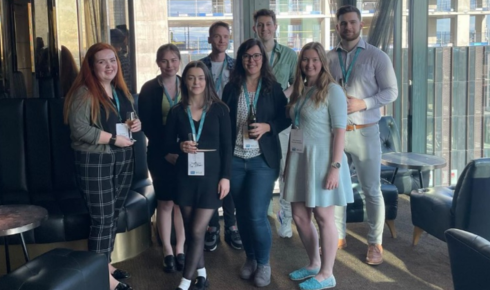
Over the past decade, the RSB has helped fund travel for more than 100 early career biologists hoping to research, study or present abroad. We asked four recipients how these travel grants helped develop and support their work
This year the Society restarted its travel grants scheme following a hiatus during the COVID-19 pandemic. Funding of up to £1,000 was once again made available to associate members and early career members to help them attend conferences, present findings or join projects that will aid their research and personal development.
Here, four of the latest grant recipients describe how the funding has helped them, as well as the sights and sounds of their visits, which included trips to Paris, Salzburg, Manchester and Mallorca.
Rosie Gallagher, University of Dundee
Travelled to the Institut Pasteur in Paris to learn more about stem cell advancements
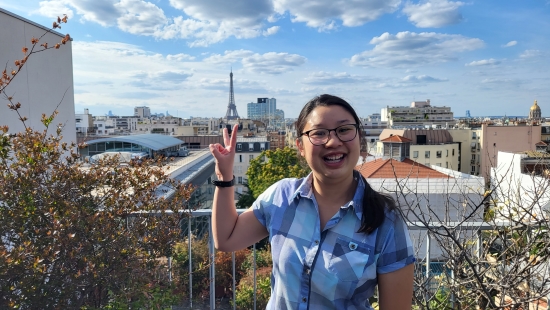 Rosie Gallagher in Paris
Rosie Gallagher in Paris
From 26 June to 8 July I participated in a course on advances in stem cell biology at the Institut Pasteur in Paris, which included practical sessions and lectures.
As a first-year PhD student, the course was an opportunity to gain experience with stem cells. Practical experience included cultivating (maintaining and passaging) induced pluripotent stem (iPS) cells. iPS cells are cells that originate in the human body, but have been reprogrammed to self-renew and make many different cell types in the body.
Other cell culture techniques included extracting and growing intestinal organoids (mini-guts), gastruloids (mini-organs mimicking a stage of development called gastrulation) and muscle stem cells. Organoids are 3D, in vitro, simplified and miniaturised versions of an organ, which mimic some properties of the actual tissue. I gained insight and context into different model systems and human iPS cells, which I am using in my project.
I was also shown how to dissect chicken embryos. This model is used to study early development, particularly a stage called somitogenesis, which is when skeletons start to form. I then studied regeneration by using worms as a model system, as some species can regrow whole segments of their body if you amputate them. The topics were diverse and, as a scientist, even if you are not researching the particular area, it gives you a broader picture of research and a different angle on your current project.
Some of the most interesting and memorable moments were meaningful discussions with speakers and peers. I love asking questions and understanding different topics. The collaborative aspect of sharing and exchanging ideas in science is so important and something I rediscovered during this course.
In the most memorable lecture the speaker discussed a case where he saved an eight-year-old boy’s life. The boy had a rare genetic condition that caused him to lose most of his skin. The speaker explained how he saved the child by using gene editing to correct the mutation and regrow the boy’s skin in vitro. The lecture was very impactful as it gave an example of the medical application of stem cell research.
Another interesting topic was the advancements made on intestinal organoids. It was surprising how we could bioprint a cellular matrix structure that supported the cultivation of organoids, enabling the organoid to closely mimic a mouse intestine. However, I also learned some of the limitations of these models, such as reproducing them with human stem cells, and the ethical implications of these technologies, public perception and how they affect the economy.
Overall, the course taught me the value of critical analysis, the limitations of using different models, and the importance of scientific integrity, communication, sharing and exchanging current ideas. I would recommend any PhD student to take this course as I have learned so much.
Emily Lupton, Centre for Advanced Biomedical Imaging, University College London
Travelled to the 18th European Molecular Imaging Meeting in Salzburg, Austria
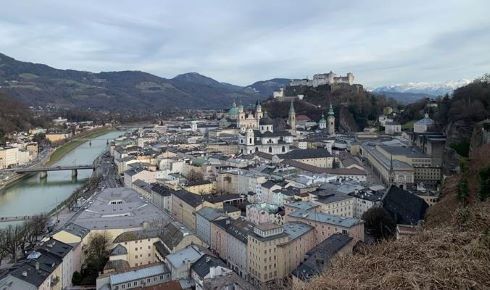 Salzburg, Austria
Salzburg, Austria
Set in the beautiful mountainous backdrop of Salzburg, Austria, the 18th European Molecular Imaging Meeting in March hosted more than 800 scientists, and covered a wide range of imaging modalities, including MRI, PET/CT and ultrasound.
The four-day conference had an expansive programme, including 30 presentation sessions, two poster sessions, a range of educational workshops, plus social activities and interdisciplinary networking opportunities. Industry professionals also attended to offer advice on equipment use and run device-specific workshops. A highlight was the opening lecture by Annemie Van der Linden, who talked about doing MRI scans on the brains of songbirds while they sing. The plenary lecture by Elizabeth M C Hillman was also interesting, exploring the wide range of microscopes her group had developed for high-speed imaging.
As I am currently analysing imaging data collected for my PhD, the educational sessions were particularly useful. The detailed description of ways to analyse PET imaging data was highly relevant to my work.
Study groups provided an opportunity to meet researchers with shared scientific interests. The cardiovascular study group ended with a social bar-hopping event spread across four different venues in Salzburg. Conference attendees were also invited to attend a Mozart concert at the Salzburg Residenz.
On the final day of the conference I presented a poster about my recent PhD work, discussing a method to quantify diffuse cardiac fibrosis using microCT. I gathered feedback and advice from other researchers.
I had many opportunities to go sightseeing in Salzburg, visiting many of the locations where The Sound of Music was filmed, including the famous Pegasus Fountain. The funicular up to Fortress Hohensalzburg offered panoramic views of the city. I even visited Mozart’s birthplace and ate lots of Mozartkugel, the small, round sweets named after the great composer!
Joshua W P Bateman, Swansea University (supported by UK Health Security Agency)
Travelled to the Inhaled Particles and NanOEH Conference 2023, Manchester
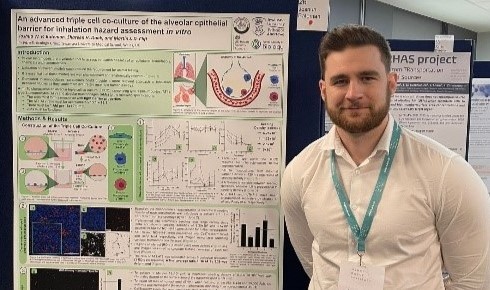 Joshua gave a talk at the Inhaled Particles and NanOEH Conference 2023
Joshua gave a talk at the Inhaled Particles and NanOEH Conference 2023
In May I took a train from Swansea to Manchester Piccadilly to attend the joint Inhaled Particles and NanOEH Conference 2023. Although I was excited about the opportunity, I was also nervous as I knew on day three of four I would be giving a talk. Thankfully, my laboratory colleagues attended too and were able to keep my spirits high on the long train journey.
For my PhD at Swansea University, supported by the UK Health Security Agency, I am examining the effects of various air pollutants on human health. As I started my PhD in April 2020, during the pandemic, I have not had much opportunity to travel to discuss my work with experts in the field.
This was my first time visiting Manchester and upon arrival at the Hilton Hotel I was amazed at the size of the building – we don’t have many skyscrapers in Wales. In fact, after an afternoon of interesting talks on in vivo nanotoxicology, conference delegates were invited to a drinks reception at Cloud 23 on the 23rd floor. The views from up there are amazing – it even has a glass floor that looks down to road level that you can walk on if you are brave enough.
The next day I attended a number of talks and presentations on the risks of micro- and nanoplastic exposure, and alternative methods of toxicity testing. I especially enjoyed this day as three members of our laboratory presented their work – it was great to see how senior members of the laboratory communicated with the audience and I learned some effective tips for my talk the following day.
My poster was on the creation and characterisation of an in vitro model of the epithelial barrier of the alveolar region of the lungs, including the three major cell types of the alveolar epithelium, cultured at anatomically relevant ratios. I received a lot of interest from conference delegates, including many at the top of the field. I really learned a lot to advise my future direction of research.
When it came to giving my talk, thankfully my nerves seemed to subside when I went on stage. I presented work that I have been doing to examine the effects of particulate matter and nitrogen dioxide air pollution on human health. In previous research it has been difficult to disentangle the effect of either pollutant individually, as they are often released from the same source. I think that my talk went down well with the audience and I was able to form some interesting discussions afterwards.
That evening we celebrated the birthday of one of my colleagues and the atmosphere in the city was great, as Manchester City had just beaten Real Madrid to make it to the Champions League final.
On the final day I attended talks on air pollution before the conference drew to a close. I was immensely proud and honoured to find out that I had won the prize for the best PhD poster.
The conference has reaffirmed my passion for inhalation toxicology. I have been instilled with new ideas and directions that I believe will drive my research to the next level. I am so grateful to the RSB for supporting me to attend this conference.
Molly Kelly, Liverpool School of Tropical Medicine
Travelled to Mallorca, Spain, to join a research project at the University of the Balearic Islands
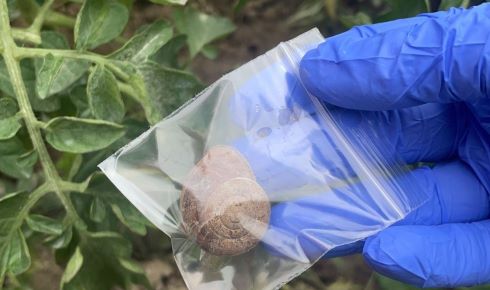 Molly collected snails from local crops as part of studies on the transmission of rat lungworm
Molly collected snails from local crops as part of studies on the transmission of rat lungworm
The rat lungworm (Angiostrongylus cantonensis) is the causative agent of eosinophilic meningitis, also known as parasitic meningitis, in humans. Gastropods are a key component in the life cycle of the parasite – their larvae mature into their infective stage inside a snail or slug, which are then consumed by rats or other mammalian hosts. Humans are ‘accidental’ hosts of the rat lungworm and are usually infected through consumption of raw or undercooked infected gastropods. The most common clinical finding is eosinophilic meningitis, leading to headaches, stiffness, nausea and, in rare cases, coma and death.
The parasite is thought to be an emerging zoonosis in Mallorca, and there is an urgent need for surveillance and monitoring to aid with control efforts. While rat lungworm has been identified in rats and hedgehogs on the island, there are no data available on the prevalence of the parasite in gastropods from agricultural land, which may serve as an important source of infection, particularly for ready-to-eat vegetables (through snail slime or accidental consumption of snails).
Thanks to the generous support of an RSB travel grant I spent three weeks in Mallorca in June 2023, working on a project led by Dr Claudia Paredes-Esquivel, a lecturer in the Laboratory of Zoology at the University of the Balearic Islands. Our aim was to contribute to understanding the epidemiology of A. cantonensis by identifying its intermediate gastropod hosts and determining the prevalence of the parasite among these hosts in agricultural land.
On the first day of my project I collected snails from a local resident’s tomato crops in Selva. We collected over 100 and transported them back to the university in small zip-lock bags.
Back at the university we speciated them and performed necropsies to identify parasites. Over the following three weeks and with the help of the wonderful team at the university (Sebastià Jaume-Ramis, Sofia Delgado-Serra and Micaela Ariadna Arango-Colonna), I performed DNA extractions on 166 gastropod samples and ran several PCRs to determine the presence of the parasite in our samples.
Our results confirm the parasite is present in gastropods from agricultural zones, but we also found that a variety of gastropods may act as intermediate hosts.
The results confirm that the rat lungworm is established in Mallorca, and that targeted control interventions are required to slow the spread of the parasite and to prevent human disease. This study forms a key component in the understanding of the epidemiology of the rat lungworm in Mallorca and encourages more similar studies addressing the topic.
Working on this project has been invaluable and I am beyond grateful to the Society for enabling me to carry out this work.
I have gained huge confidence in a variety of laboratory skills and have developed new expertise both in the lab and out in the field. I am also a confident Spanish speaker, and being able to combine language and my passion for science has been an immensely rewarding experience.
Compiled by the Biologist editorial team and Eden Bloomfield, RSB Membership Engagement Officer.


